I recently purchased a PM 3520C (upgraded from Laguna 12/16) and also a ¾" mat for comfort. Installing the 4 inch included risers would have made the lathe too high for me. With the leg levelers adjusted as high as was safe the spindle height was too low for me. I purchased 4 hockey pucks (dense vulcanized rubber) and placed one under each of the levelers and this brought the lathe to a very comfortable turning height. The extra inch did make a significant difference in comfort. I don't turn large pieces but when turning 12 inch blanks the lathe remained quite stable with no movement. I suppose if one needed two inches, two pucks could be epoxied together. Wondering if anyone came up with other solutions for small adjustments to lathe height. I know some of you are fortunate to have lathes that come with adjustable stands making this a non-issue.
-
December 2025 Turning Challenge: Single Tree! (click here for details) -
Congratulations to Bob Henrickson, People's Choice in the November 2025 Turning Challenge (click here for details) -
Congratulations to Steven Gordon for "Dropped Ice Cream Cone" being selected as Turning of the Week for December 9, 2025 (click here for details) -
Welcome new registering member. Your username must be your real First and Last name (for example: John Doe). "Screen names" and "handles" are not allowed and your registration will be deleted if you don't use your real name. Also, do not use all caps nor all lower case.
You are using an out of date browser. It may not display this or other websites correctly.
You should upgrade or use an alternative browser.
You should upgrade or use an alternative browser.
Fine tuning lathe height
- Thread starter John Husokowski
- Start date
I guess I'm not as sensitive. I'm pretty sure I could compensate for an inch of lathe height change without really noticing the difference. My elbows are about the only joints that still work quite well.
Hi John. Hockey pucks, clever! I'd think those will last a good long time, great idea. And it looks like the diameter is about perfect as well, making them unobtrusive. And the friction the rubber gives to the floor and the machine feet should keep everything stable as well.
I don't think I'd go double-high with the pucks, even glued together. At some point the relative height slenderness, and whatever "give" that hard rubber may have, may work against overall stability. If any extra height is needed, I'd put a slightly oversized (length x width) plywood (void free, like Baltic birch), hardwood, or even a steel baseplate under the puck.
I've generally used hardwood boards, or sometimes Baltic birch plywood, in whatever thickness to raise or shim stationary gear in my shop. My shop floor is a disaster, everything needs to be leveled.
And I agree that even an inch of adjustment can make a real difference on the comfort scale. Over the years, for lathes and bench grinders, I've found that the height of the inside 90 degree bend of my elbow (arm hanging loose, lower arm bent up parallel to the floor) works very well for me and my two non-adjustible headstock lathes. Just right for bowl-type turning, and not too high for spindle work. But this is the max height for me, higher than that and tool ergonomics (the gouges and such) get clumsy and unnatural to control.
I don't think I'd go double-high with the pucks, even glued together. At some point the relative height slenderness, and whatever "give" that hard rubber may have, may work against overall stability. If any extra height is needed, I'd put a slightly oversized (length x width) plywood (void free, like Baltic birch), hardwood, or even a steel baseplate under the puck.
I've generally used hardwood boards, or sometimes Baltic birch plywood, in whatever thickness to raise or shim stationary gear in my shop. My shop floor is a disaster, everything needs to be leveled.
And I agree that even an inch of adjustment can make a real difference on the comfort scale. Over the years, for lathes and bench grinders, I've found that the height of the inside 90 degree bend of my elbow (arm hanging loose, lower arm bent up parallel to the floor) works very well for me and my two non-adjustible headstock lathes. Just right for bowl-type turning, and not too high for spindle work. But this is the max height for me, higher than that and tool ergonomics (the gouges and such) get clumsy and unnatural to control.
Roger Wiegand
Beta Tester
Perhaps the next innovation in high end lathes will incorporate an electric lift to allow you to change the height on the fly. That would actually be really nice to have, my back would appreciate some variation. Won't be cheap to implement in a way that doesn't increase vibration.
- Joined
- Apr 27, 2004
- Messages
- 9,302
- Likes
- 6,056
- Location
- Lakeland, Florida
- Website
- www.hockenberywoodturning.com
Great. I like turning spindles and hollowing ornament balls a couple inches higher.Perhaps the next innovation in high end lathes will incorporate an electric lift to allow you to change the height on the fly. That would actually be really nice to have, my back would appreciate some variation. Won't be cheap to implement in a way that doesn't increase vibration.
I found it is very important for me to have a height that is right and 1” can make a difference. Not short term, but over a long period I began having back problems with 6 weeks of therapy to get back to normal. My lathe height was too low. I ended up selling that lathe and bought a lathe where I can adjust the height to my liking. The rule of thumb is the spindle hight should be at elbow height. However I found I like my spindle height a little higher.
I did the same thing with one of my lathes - it was just an inch or so too low for comfort. In my case, I simply cut four squares of white oak and drilled recesses in the top with a forstner bit to fit the lathe feet. Used them for years, still do on that lathe.I purchased 4 hockey pucks (dense vulcanized rubber) and placed one under each of the levelers and this brought the lathe to a very comfortable turning height.
One thing about lathe height - once you find the lathe height perfect for you, consider the height of the grinders and such for sharpening. I find that if the centers of the wheels are the same height as the lathe he helps with moving the tool, especially with grinding free hand as I always do with some tools. It feels more natural. Some of the movements at the grinder are similar to those at the lathe.
While considering heights, something bugs me about tool rest height. Since it often has to be adjusted when changing tools or using a different type of cut, I often find myself moving it up and down a tiny bit so it's JUST right.
If I were king, I might order my subjects to construct an electro-mechanical system that would bump the rest height up or down by a settable distance. I'd probably set it to 1mm or less. Or maybe several buttons, 1/2mm, 1mm, 3, 5 and 7mm, etc.
Hey, here's something related that occasionally people don't know: when adjusting the leg levelers or even after moving the lathe. ALWAYS check the alignment by putting points in both the headstock and tailstock and sliding the tailstock to bring the points together. If they don't line up exactly, the lathe is out of alignment which can cause various problems, especially with certain types of turning. It might seem odd, but a heavy long cast iron lathe bed can easily warp and twist. (I don't know about the non-cast iron lathes.) To realign it is simple, simply adjust either one of the front or one of the back levelers a bit until the points align. For example, if the tailstock point is a bit closer to you than it should be, crank up a tiny bit on the front leveler on the tailstock end OR the back leveler on the headstock end. Note that simply moving the lathe across the shop can change the alignment since most shop floors are not precisely surface-plate flat. Also, note that the lathe doesn't really have to be level - it can be on a shallow slope and still work fine as long as it's aligned.
Once Mark StLeger was teaching in Knoxville and when he got to the point of doing something that required critical alignment, he checked and our club lathe was not right. I said, hey, I can fix that! So during the break I did what I mentioned above and he continued with the project.
If you haven't hung out with Mark, he is an incredibly nice guy, soft spoken, brilliant, kind, generous, creative, and talented. This pic is from when he visited my farm one winter when he was in the area. (The shop is heated but we just came in after socializing with the llamas!)
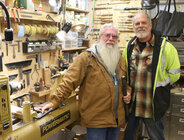
JKJ
Last edited:
While considering heights, something bugs me about tool rest height. Since it often has to be adjusted when changing tools or using a different type of cut, I often find myself moving it up and down a tiny bit so it's JUST right.
If I were king, I might order my subjects to construct an electro-mechanical system that would bump the rest height up or down by a settable distance. I'd probably set it to 1mm or less. Or maybe several buttons, 1/2mm, 1mm, 3, 5 and 7mm, etc.
Sorby do a gizmo for doing just that with the toolrest: https://robert-sorby.co.uk/product/trac-tool-rest-adjustment-collar/ allows you to adjust the height by a few millimetres with a twist. Never used them but saw a review in a magazine
Thanks, first I’ve heard of those. I’ll order one for evaluation.
Same. My spindle height is at 49", a couple inches higher than my elbow. Anything lower causes serious back pain. My 3520C is on the risers, bolted to 4x4's on each side.I found it is very important for me to have a height that is right and 1” can make a difference. Not short term, but over a long period I began having back problems with 6 weeks of therapy to get back to normal. My lathe height was too low. I ended up selling that lathe and bought a lathe where I can adjust the height to my liking. The rule of thumb is the spindle hight should be at elbow height. However I found I like my spindle height a little higher.
I like the hockey puck idea. I needed additional height for my 3520 (I’m 6’3”) so I added castors which allow me to move it around easily, along with another inch of oak blocks to get the height I desired. As John K Jordan said - make sure to set up your grinder nearby with the same spindle height.
Attachments
I've always liked my lathe up higher than elbow height. On my old Powermatic, I had the feet extended and they eventually folded. I made new ones with some plywood "pucks" for feet and with stonger bolts. I donated the lathe to a local charity that was creating a community woodshop and I guess they're stuck with a taller minimum height. 
The idea to use hockey pucks is brilliant. I bought a dozen of them for other projects and shop uses, (like jack pads in the garage) but I think it was after I had made the wood feet.
The legs on my Robust have a pretty wide adjustment range. (very nice feature) Each leg has its own clamping bolt so it's very quick and easy to change the height.
The idea to use hockey pucks is brilliant. I bought a dozen of them for other projects and shop uses, (like jack pads in the garage) but I think it was after I had made the wood feet.
The legs on my Robust have a pretty wide adjustment range. (very nice feature) Each leg has its own clamping bolt so it's very quick and easy to change the height.
I realize this is an old thread.
I apparently need to raise my lathe about 8 inches.
It's an older Jet 1642.
The spindle center is 44 1/2 inches from the floor and my elbow is 52 ish inches from said floor
The leveling feet are threaded 3/8X16
There's no way I'm comfortable with 8 inches of 3/8 ths threaded rod supporting my lathe.
I could remove the legs then drill and tap them for 1/2 or 9/16th threads and fabricate feet.
With lock nuts on each side of the legs it'd be secure and adjustable.
I was wondering what other folks here have done to raise a lathe that much?
I did like the hockey puck idea.
Craig
I apparently need to raise my lathe about 8 inches.
It's an older Jet 1642.
The spindle center is 44 1/2 inches from the floor and my elbow is 52 ish inches from said floor
The leveling feet are threaded 3/8X16
There's no way I'm comfortable with 8 inches of 3/8 ths threaded rod supporting my lathe.
I could remove the legs then drill and tap them for 1/2 or 9/16th threads and fabricate feet.
With lock nuts on each side of the legs it'd be secure and adjustable.
I was wondering what other folks here have done to raise a lathe that much?
I did like the hockey puck idea.
Craig
Roger Wiegand
Beta Tester
8x8 spanning the legs on each end, lag the lathe into the 8x8's. Or build up to 8" by stacking 2x6's and screwing them together. Put a piece of heavy rubber mat underneath the stack to help prevent movement and absorb vibration.
Odie
Panning for Montana gold, with Betsy, the mule!
Thanks, first I’ve heard of those. I’ll order one for evaluation.
I'm interested in hearing your thoughts on this, John......
I've been using thumb adjusting hose clamps for this, and it makes life easier with quick adjustments......but, open to new ideas.
What is the price of those? (didn't see one at the link)
=o=
I realize this is an old thread....I was wondering what other folks here have done to raise a lathe that much?
Old threads are here for that reason, to be found and used!
I raised my 1642 years ago (before I got old enough to start shrinking) by cutting squares of oak and drilling slightly into the top with a forstner bits to make shallow recesses to fit the stock leveling pads. Now I'm 3" shorter and don't need risers.
If wanting to raise a lathe by 8" I might consider a variation on the same idea - make a sturdy wood piece that would sit on the floor an allow two recesses, one for each leveling foot on one end of the lathe. Make a second riser for the other end. To make the thing stable enough I might consider a trapezoid shape cross section, wide at the bottom. The recesses would keep the pads from slipping.
The method wouldn't need drilling and taping and use the same levelers that came with the lathe, perhaps useful to the next person if you sell it some day.
The stock levelers are perfect for adjustment to align the lathe if the floor is not perfectly flat.
Oh, I see that @Roger Wiegand just posted something similar while I was typing. I sometimes take a long time to finish a reply. I like his idea of a rubber pad under the wood, as long as it wasn't thick and squishy. Otherwise some maybe sort of plastic. Might depend on what type of floor.
JKJ
I'm interested in hearing your thoughts on this, John......
I've been using thumb adjusting hose clamps for this, and it makes life easier with quick adjustments......but, open to new ideas.
What is the price of those? (didn't see one at the link)
=o=
I remember looking at the Sorby tool rest adjustment gizmo, also can't remember if I couldn't find the price or found it and it was expensive. Regardless, I never followed through and ordered one to test. I just continued to adjust the way I always have. And for some reason got more efficient, use my left hand to get the desired mm or two up or down as needed for different tools.
Odie
Panning for Montana gold, with Betsy, the mule!
(before I got old enough to start shrinking)
You too?
I'm wondering if shrinking will ever stop......I've lost 2 full inches from my youthful height!
=o=
You too?
I'm wondering if shrinking will ever stop......I've lost 2 full inches from my youthful height!
=o=
My wife said according to the doctor's height scale she's lost 4-5 inches.
We are not 20 anymore, as when we got married (in July of 1970). I was 6'1" and thin as a rail.
JKJ
W ell as we age, we perhaps don't bend so gracefully as we once did. So lathe height will vary , for me mine is about 4" or 100mm higher that recommended height for me. What this does for me, is it places the centre of the piece at arm pit height. Which i find ideal for hollowing, the handle is securley tucked into the armpit and i hollow with full body movement. Plus im well out of the danger zone if it takes off, mind you if it's deep piece it would be flopping around on the hollower shaft. That's always interesting .
As to height yeah. I am the shortest person in my family, even my mother was taller. But when she passed in her 70's I was taller than her , such is life
Craig I’m 6’ 4” and had a Jet 14/42 for years. I had a 6x6 PT block long enough to catch both feet one each side. Worked great for years. I also turn a lot of out of balance stuff with no issues.I realize this is an old thread.
I apparently need to raise my lathe about 8 inches.
It's an older Jet 1642.
The spindle center is 44 1/2 inches from the floor and my elbow is 52 ish inches from said floor
The leveling feet are threaded 3/8X16
There's no way I'm comfortable with 8 inches of 3/8 ths threaded rod supporting my lathe.
I could remove the legs then drill and tap them for 1/2 or 9/16th threads and fabricate feet.
With lock nuts on each side of the legs it'd be secure and adjustable.
I was wondering what other folks here have done to raise a lathe that much?
I did like the hockey puck idea.
Craig
- Joined
- Feb 28, 2021
- Messages
- 1,765
- Likes
- 1,578
- Location
- Roulette, PA
- Website
- www.reallyruralwoodworks.com
I got mine on Amazon, very affordable, quite handy for fine adjustments on tool rest (and repeatable if you know exactly how much to twist to get your desired height) Appears it has jumped about 45% in price since I got mine, but still reasonable I think https://www.amazon.com/dp/B0C4PR2CRK?psc=1&ref=ppx_pop_dt_b_product_detailsI'm interested in hearing your thoughts on this, John......
I've been using thumb adjusting hose clamps for this, and it makes life easier with quick adjustments......but, open to new ideas.
What is the price of those? (didn't see one at the link)
=o=
You folks who are using wood blocks to raise the height are using soft woods?
I can get 4X4 Fir and PT right around the corner at Home Depot.
If I wanted to use hardwoods I'd have to drive about 45 min to this place.
 goosebaylumber.net
goosebaylumber.net
It's a nice old timey lumber yard.
I can get 4X4 Fir and PT right around the corner at Home Depot.
If I wanted to use hardwoods I'd have to drive about 45 min to this place.
Goosebay Sawmill & Lumber, Inc. | Family Run Since 1978
Goosebay Sawmill & Lumber provides a wide range of specialty products including fine hardwoods & softwoods, finishes, rough sawn native lumber.
 goosebaylumber.net
goosebaylumber.net
It's a nice old timey lumber yard.
You folks who are using wood blocks to raise the height are using soft woods?
I used oak but pine or PT pine should be fine - even big lathes are not real heavy and the compression should not be a problem. However, as mentioned I'd make it wider at the bottom for stability. If looking for 8" rise I'd go for 8x8 blocks or at least, lag-screw a wider board on the bottom.
Note that if you drive by a construction site where someone is putting up a deck they might give you free blocks long enough. They usually just haul offcuts to the dump. I saved a bunch of post and board offcuts from when a friend rebuilt my back deck. Some were 4' long.
Could even call around to companies that do such work - maybe they could point you towards a contractor.
Or maybe call a timber frame company like Timberpeg - they build all over the country. - you might be able to get some BIG blocks! For example, our house was built with pine 8x8 and 6x6 posts and beams varying from 4x6 to 8x12". I got some 12x12" blocks from one builder.
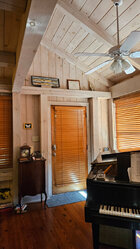
When a friend had his timber frame house built he collected a trailer-full of "scraps" too nice to discard. Great for making things for the shop!
JKJ
Last edited:
If worried about the weight of the machine pressing into softwood riser blocks, you could top that block with blank electrical junction box covers from the hardware store. They are zinc galvanized so the treated lumber, if using it, doesn't corrode the plate, and they are a thick gauge metal not prone to deform themselves, and should spread out the weight just a little more. And dirt cheap, too.
May want to drill a couple small holes through them for nails or screws, to keep them attached to the lumber, and avoid them sliding off the lumber.
May want to drill a couple small holes through them for nails or screws, to keep them attached to the lumber, and avoid them sliding off the lumber.
It depends on what I am doing. For hollow forms, I like higher, for boxes, fairly high, for bowls a little above elbow height.
robo hippy
robo hippy
Now I'm 3" shorter and don't need risers.
LOL. Put the hat back on.
My risers are 4x4, so not going quite as high as you are. I used what scrap I had available, which happened to be tulip tree (aka yellow poplar).You folks who are using wood blocks to raise the height are using soft woods?
I can get 4X4 Fir and PT right around the corner at Home Depot.
If I wanted to use hardwoods I'd have to drive about 45 min to this place.
Goosebay Sawmill & Lumber, Inc. | Family Run Since 1978
Goosebay Sawmill & Lumber provides a wide range of specialty products including fine hardwoods & softwoods, finishes, rough sawn native lumber.goosebaylumber.net
It's a nice old timey lumber yard.
8" is a lot. Are you using the "spindle at elbow height" measurement? I assume you are sure you need to come up 8".
I see the Woodcraft has them for 39.99I'm interested in hearing your thoughts on this, John......
I've been using thumb adjusting hose clamps for this, and it makes life easier with quick adjustments......but, open to new ideas.
What is the price of those? (didn't see one at the link)
=o=
I ended up using a couple of pieces of fir 4X4 under the legs for starters.
Those bring the tail stock center to about 3 inches below my elbow with my hand on the opposite shoulder.
I'll give it a try and see how it feels.
I will admit to trying some 5 inch, "heavy duty" swivel locking casters under the legs.
They turned out to be a wobbly un-stable waste of time because of the play in the bearing plates.
I did make most of a steady rest today, though I still need to figure out how to mount it.
My wood working skills kinda pale in comparison to my mechanical ones.
New learning curves are a good thing.
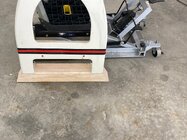
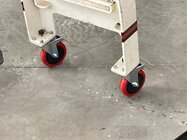
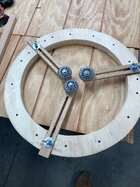
Those bring the tail stock center to about 3 inches below my elbow with my hand on the opposite shoulder.
I'll give it a try and see how it feels.
I will admit to trying some 5 inch, "heavy duty" swivel locking casters under the legs.
They turned out to be a wobbly un-stable waste of time because of the play in the bearing plates.
I did make most of a steady rest today, though I still need to figure out how to mount it.
My wood working skills kinda pale in comparison to my mechanical ones.
New learning curves are a good thing.





